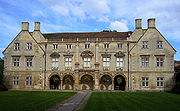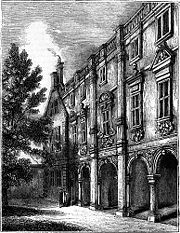
Pepys Library
Encyclopedia
The Pepys Library of Magdalene College, Cambridge
, is the personal library
collected by Samuel Pepys
which he bequeathed to the college following his death in 1703.
Pepys was a lifelong bibliophile and carefully nurtured his large collection of books, manuscripts, and prints. At his death, there were more than 3,000 volumes, including the diary, all carefully catalogued and indexed; they form one of the most important surviving 17th century private libraries
.
Pepys made detailed provisions in his will for the preservation of his book collection; and, when his nephew and heir, John Jackson, died, in 1723, it was transferred, intact, to Magdalene. The bequest included all the original bookcases and his elaborate instructions that placement of the books "...be strictly reviewed and, where found requiring it, more nicely adjusted". Under the terms of the bequest, none of the books may be sold, and no additional ones may be added to the library.
The library is housed in a room on the first floor of the Pepys Building in the second court of the college. It contains 3,000 books preserved in Pepys's own bookcases for them (perhaps those his journal attributes to Sympson the Joiner
) and organised by size as he had catalogued them.

A selection of the most interesting volumes are on display.
 The Pepys Building is the principal ornament of the College and of considerable architectural interest. The plainer rear is of brick while the front is neo-classical
The Pepys Building is the principal ornament of the College and of considerable architectural interest. The plainer rear is of brick while the front is neo-classical
and in Ketton stone
. Built between 1670 and 1703, it has been described as "a highly remarkable classical building of the date".
Construction was slow for want of money, but the project was revived after advice was sought from Robert Hooke
in 1677. Samuel Pepys made three subscriptions to the building fund.
On the front of the building is the painted inscription Bibliotheca Pepysiana 1724 which records the date of arrival of the library; above it are painted Pepys's arms and his motto "Mens cujusque is est quisque" ("The mind's the man" taken from Cicero
's De re publica
).
Magdalene College, Cambridge
Magdalene College is a constituent college of the University of Cambridge, England.The college was founded in 1428 as a Benedictine hostel, in time coming to be known as Buckingham College, before being refounded in 1542 as the College of St Mary Magdalene...
, is the personal library
Library
In a traditional sense, a library is a large collection of books, and can refer to the place in which the collection is housed. Today, the term can refer to any collection, including digital sources, resources, and services...
collected by Samuel Pepys
Samuel Pepys
Samuel Pepys FRS, MP, JP, was an English naval administrator and Member of Parliament who is now most famous for the diary he kept for a decade while still a relatively young man...
which he bequeathed to the college following his death in 1703.
Pepys was a lifelong bibliophile and carefully nurtured his large collection of books, manuscripts, and prints. At his death, there were more than 3,000 volumes, including the diary, all carefully catalogued and indexed; they form one of the most important surviving 17th century private libraries
Library
In a traditional sense, a library is a large collection of books, and can refer to the place in which the collection is housed. Today, the term can refer to any collection, including digital sources, resources, and services...
.
Pepys made detailed provisions in his will for the preservation of his book collection; and, when his nephew and heir, John Jackson, died, in 1723, it was transferred, intact, to Magdalene. The bequest included all the original bookcases and his elaborate instructions that placement of the books "...be strictly reviewed and, where found requiring it, more nicely adjusted". Under the terms of the bequest, none of the books may be sold, and no additional ones may be added to the library.
The library is housed in a room on the first floor of the Pepys Building in the second court of the college. It contains 3,000 books preserved in Pepys's own bookcases for them (perhaps those his journal attributes to Sympson the Joiner
Sympson the Joiner
Sympson the Joiner was a joiner who worked at the Royal Naval Dockyard at Woolwich in London. He is remembered only because Samuel Pepys mentions his name several times in his diary....
) and organised by size as he had catalogued them.

The collection
The most important items in the Library are the six original bound manuscripts of Pepys's diary but there are other remarkable holdings, including:- Naval records compiled by Pepys when he was Secretary to the Admiralty, including two of the 'Anthony RollAnthony RollThe Anthony Roll is a record of ships of the English Tudor navy of the 1540s, named after its creator, Anthony Anthony. It originally consisted of three rolls of vellum, depicting 58 naval vessels along with information on their size, crew, armament, and basic equipment. The rolls were...
s', illustrating the Royal Navy's ships circa 1546, including the Mary RoseMary RoseThe Mary Rose was a carrack-type warship of the English Tudor navy of King Henry VIII. After serving for 33 years in several wars against France, Scotland, and Brittany and after being substantially rebuilt in 1536, she saw her last action on 1545. While leading the attack on the galleys of a... - Pepys' own copy of Isaac NewtonIsaac NewtonSir Isaac Newton PRS was an English physicist, mathematician, astronomer, natural philosopher, alchemist, and theologian, who has been "considered by many to be the greatest and most influential scientist who ever lived."...
's Philosophiæ Naturalis Principia Mathematica - Incunabula by William CaxtonWilliam CaxtonWilliam Caxton was an English merchant, diplomat, writer and printer. As far as is known, he was the first English person to work as a printer and the first to introduce a printing press into England...
, Wynkyn de WordeWynkyn de WordeWynkyn de Worde was a printer and publisher in London known for his work with William Caxton, and is recognized as the first to popularize the products of the printing press in England....
and Richard PynsonRichard PynsonRichard Pynson was one of the first printers of English books. The 500 books he printed were influential in the standardisation of the English language... - Sixty medieval manuscripts
- The Pepys ManuscriptPepys ManuscriptThe Pepys Manuscript is a late fifteenth-century English choirbook. Along with the Ritson Manuscript it is much less elaborate than the Eton, Lambeth and Caius Choirbooks, it contains shorter and simpler pieces which appear to have been written for smaller and less able choirs. The book received...
: a late fifteenth-century English choirbookChoirbookA Choirbook is a large format manuscript used by choirs in churches or cathedrals during the Middle Ages and Renaissance. The book is large enough for the entire choir to read from one book. Often for polyphonic works all the musical parts or voices of a piece of music are presented on a single... - Sir Francis Drake's personal almanacAlmanacAn almanac is an annual publication that includes information such as weather forecasts, farmers' planting dates, and tide tables, containing tabular information in a particular field or fields often arranged according to the calendar etc...
- Over 1,800 printed ballads: one of the finest collections in existence.
A selection of the most interesting volumes are on display.
Visiting
The library is open to the public, but has very restricted opening times (typically 2.30–4.30pm during the quietest months of the academic year), but it is best to contact the college for current times.Pepys Building

Neoclassical architecture
Neoclassical architecture was an architectural style produced by the neoclassical movement that began in the mid-18th century, manifested both in its details as a reaction against the Rococo style of naturalistic ornament, and in its architectural formulas as an outgrowth of some classicizing...
and in Ketton stone
Ketton stone
Ketton stone is a Jurassic oolitic limestone used as a building stone for many centuries. It is named after the village of Ketton in Rutland, England....
. Built between 1670 and 1703, it has been described as "a highly remarkable classical building of the date".
Construction was slow for want of money, but the project was revived after advice was sought from Robert Hooke
Robert Hooke
Robert Hooke FRS was an English natural philosopher, architect and polymath.His adult life comprised three distinct periods: as a scientific inquirer lacking money; achieving great wealth and standing through his reputation for hard work and scrupulous honesty following the great fire of 1666, but...
in 1677. Samuel Pepys made three subscriptions to the building fund.
On the front of the building is the painted inscription Bibliotheca Pepysiana 1724 which records the date of arrival of the library; above it are painted Pepys's arms and his motto "Mens cujusque is est quisque" ("The mind's the man" taken from Cicero
Cicero
Marcus Tullius Cicero , was a Roman philosopher, statesman, lawyer, political theorist, and Roman constitutionalist. He came from a wealthy municipal family of the equestrian order, and is widely considered one of Rome's greatest orators and prose stylists.He introduced the Romans to the chief...
's De re publica
De re publica
De re publica is a dialogue on Roman politics by Cicero, written in six books between 54 and 51 BC. It is written in the format of a Socratic dialogue in which Scipio Africanus Minor takes the role of a wise old man — an obligatory part for the genre...
).
Further reading
- Bibliotheca Pepysiana, London: Sidgwick and Jackson, 1913-40 (reissued by Cambridge University Press, 2009; ISBN 9781108003124) pt. 1. "Sea manuscripts, by Dr. J. R. Tanner. - pt. 2. General introduction, by F. Sidgwick, and Early printed books to 1558, by E. Gordon Duff. - pt. 3. Mediaeval manuscripts, by Dr. M. R. James. - pt. 4. Shorthand books, with biographical and bibliographical notes, by W. J. Carlton.

